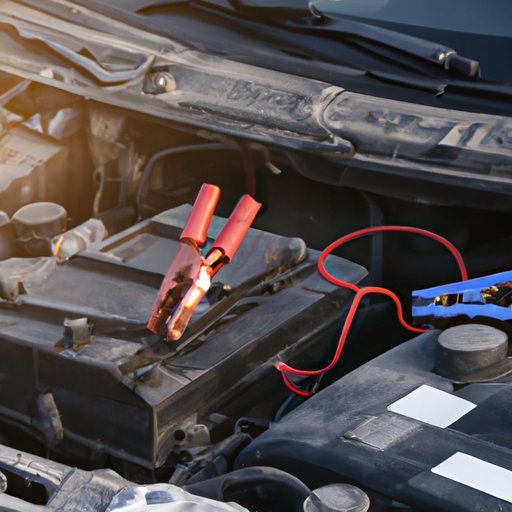
Introduction
When you’re in a hurry to get somewhere, the last thing you want is a dead car battery. Luckily, jumpstarting a car with cables is a quick and easy solution to get you back on the road again. In this article, we will cover everything you need to know about how to jumpstart a car with cables.
Step-by-Step Guide
Jumpstarting a car means connecting a working car battery to a dead one to transfer power so the dead battery can start the engine. Before you begin, gather the following materials: a working car battery, jumper cables, and protective gear such as gloves and safety glasses.
1. Position the cars close to each other, then turn off both ignition switches.
2. Locate the red positive and black negative terminals on both car batteries.
3. Connect one end of the red cable to the positive (+) terminal of the working battery.
4. Connect the other end of the red cable to the positive (+) terminal of the dead battery.
5. Connect one end of the black cable to the negative (-) terminal of the working battery.
6. Connect the other end of the black cable to a metal part of the dead car, such as a bolt.
7. Start the engine of the working car and let it run for a few minutes.
8. Try starting the engine of the dead car. If it doesn’t start, let it charge for a few more minutes before trying again.
9. Once the dead car is running, remove the cables in the reverse order of how they were connected.
Precautions
Before jumpstarting a car with cables, ensure that safety measures are taken to avoid dangerous scenarios. Park the cars on flat ground and leave them in neutral or park with the engine off. Ensure that the jumper cables don’t touch each other or any metal while they are connected to the batteries. Lastly, make sure that the jumpstarting process is done in a well-ventilated area to prevent the accumulation of combustible gases in the air.
Troubleshooting
Common problems that may prevent a successful jumpstart include incorrectly connected cables, corroded, dirty or loose battery terminals, a dead alternator, or other electrical problems. If the car still doesn’t start, try to rev the engine of the working car or wiggle the cables to see if there is a connection problem.
Safety Tips
Stay safe during jumpstarting by wearing protective gear and ensuring that the cables are not twisted or tangled. Do not smoke during the process, and do not touch the jumper cables while the cars are being started. Once the dead car is running, keep the engine running for at least 30 minutes so that the battery can fully recharge. Lastly, do not let the working and dead batteries touch each other.
DIY vs Professional Help
Jumpstarting a car with cables is easy enough to do on your own, but if there are additional problems such as a completely dead battery or electrical faults, it may be best to seek professional help.
Understanding the Battery
A car battery works by converting stored chemical energy into electrical energy used to start the engine and to run the electrical systems. To test a car battery, use a voltmeter and check if the reading is between 12.6-12.8 volts. If the reading is below 12.0 volts, charge the battery properly or replace it if necessary.
Maintenance
Proper maintenance of the car battery can prevent the need for jumpstarting altogether. Regularly check the battery’s terminals for dirt or corrosion and clear them if necessary. Turn off all lights and the radio when exiting your car and avoid making short trips as this can cause the battery to drain faster. Lastly, make sure that the battery is securely fastened to the vehicle to prevent shaking while the car is in motion.
Conclusion
Overall, jumpstarting a car with cables is an easy process that can save you time and money. Remember to take safety precautions, follow the steps carefully, and regularly maintain your car battery to avoid dead battery issues.





